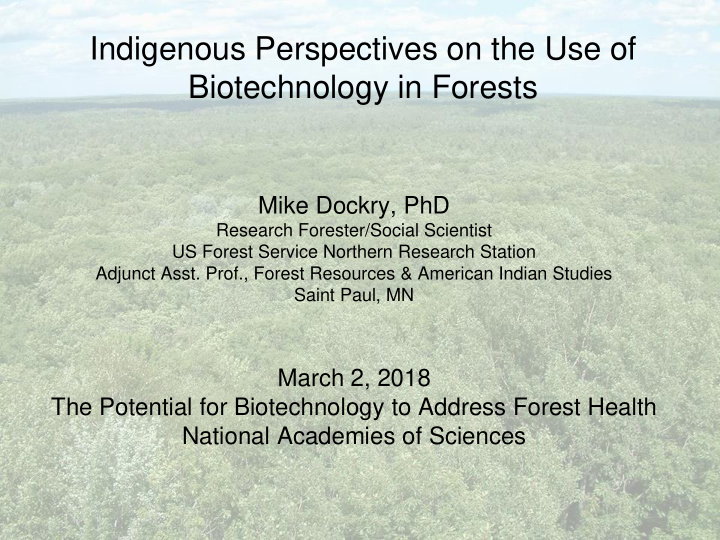



Indigenous Perspectives on the Use of Biotechnology in Forests Mike Dockry, PhD Research Forester/Social Scientist US Forest Service Northern Research Station Adjunct Asst. Prof., Forest Resources & American Indian Studies Saint Paul, MN March 2, 2018 The Potential for Biotechnology to Address Forest Health National Academies of Sciences
Mike Dockry • Registered member of Citizen Potawatomi Nation • B.S. UW Madison; M.S. Penn State; Ph.D. Forestry & Geography UW Madison • Environmental Planning Intern – Oneida Nation of Wisconsin • Peace Corps – Bolivia • Assistant Forest Planner – Green Mtn. & Finger Lakes NF • US Forest Service Liaison to College of Menominee Nation • USFS Research Scientist • UMN FNR & AIS
Presentation Outline 1. Introduction – American Indian Lands 2. Introduction – Tribal Relations 3. Some Perspectives on Biotechnology and Forest Health 4. Questions & Discussion
American Indian Forestry • 570+ Federally Recognized Tribes • 302 have significant Forestlands • 18 million acres (7.3 million ha) • Tribes managed their lands to meet many goals for generations • Managed through many changes • All tribes are different: separate nations, cultures and history • All forests were once tribal forests
US Forest Service Tribal Relations • American Indian tribes have inherent rights to United States Forest Service (USFS) system lands, resources, and programs • Codified in treaties, US Constitution, case law, Presidential Executive Orders, USDA Regulations, and the USFS Handbook. • All federal agencies are legally required to consult with tribes.
Materials for cultural activities; hunting and fishing; spiritual and religious ceremonies; access to sacred sites.
Perspectives on Biotech and Forest Health #1: Tribes are diverse
Perspectives on Biotech and Forest Health #2: Tribes are resilient and forward thinking Confronting Climate Change in the Great Lakes Region (Kling et al. 2003)
Perspectives on Biotech and Forest Health #3: We are all related. Plants and animals are relatives.
Think about what it means to be relatives
UMN, Tribes, and Manoomin
“ We object to the exploitation of our wild rice for pecuniary gain…We are of the opinion that the wild rice rights assured by treaty accrue not only to individual grains of rice, but to the very essence of the resource .” Norman Deschampe, Minnesota Chippewa Tribal President 1998 Letter to University Minnesota President See: https://www.cfans.umn.edu/wildrice
Forest Health vs. Commercialization of sacred relative?
Conclusions • There is no one tribal voice • Need to listen to tribal perspectives • Building relationships is key • Tribes have been excluded in past biotech conversations • Tribal relations takes time, leadership, and understanding • Tribal perspectives on forest health need to be incorporated in biotech discussions and other discussions… maybe other solutions
Questions & Discussion mdockry@fs.fed.us
Recommend
More recommend